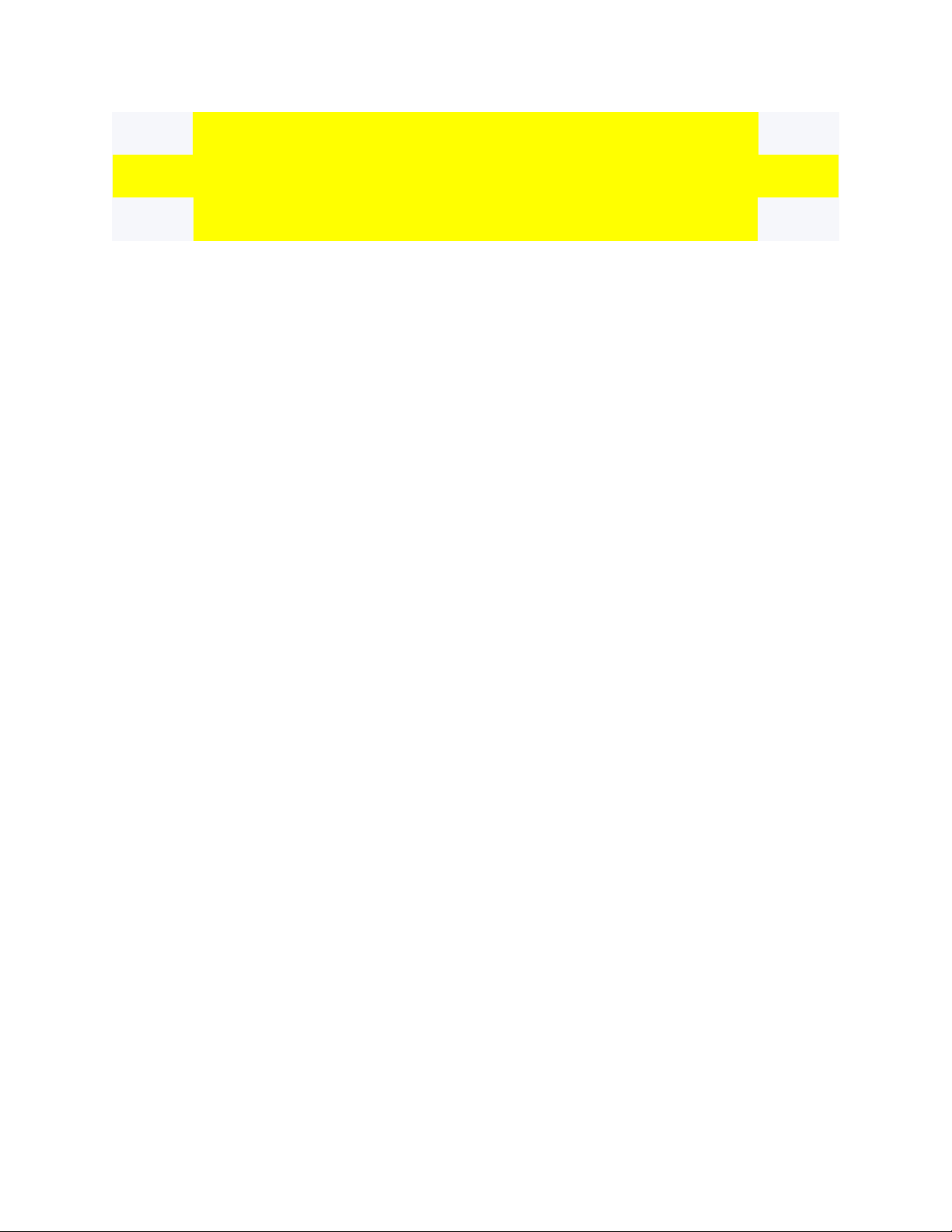
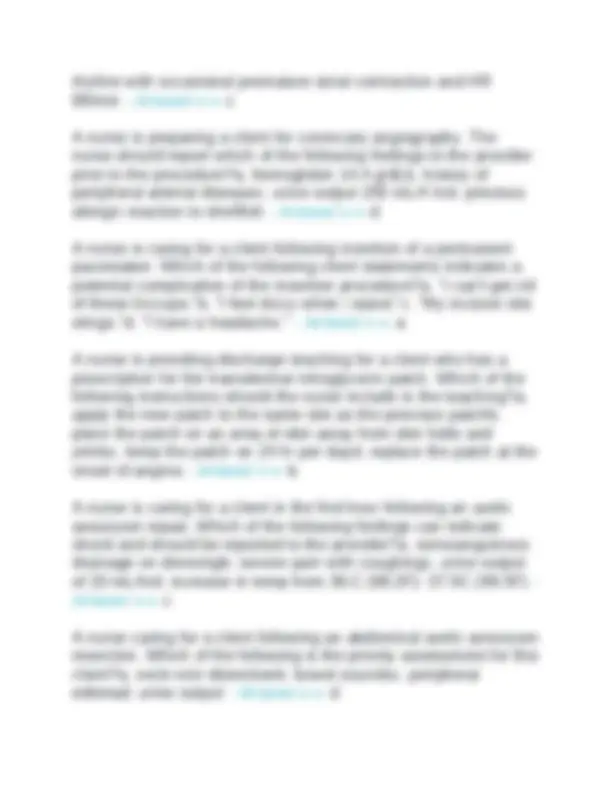
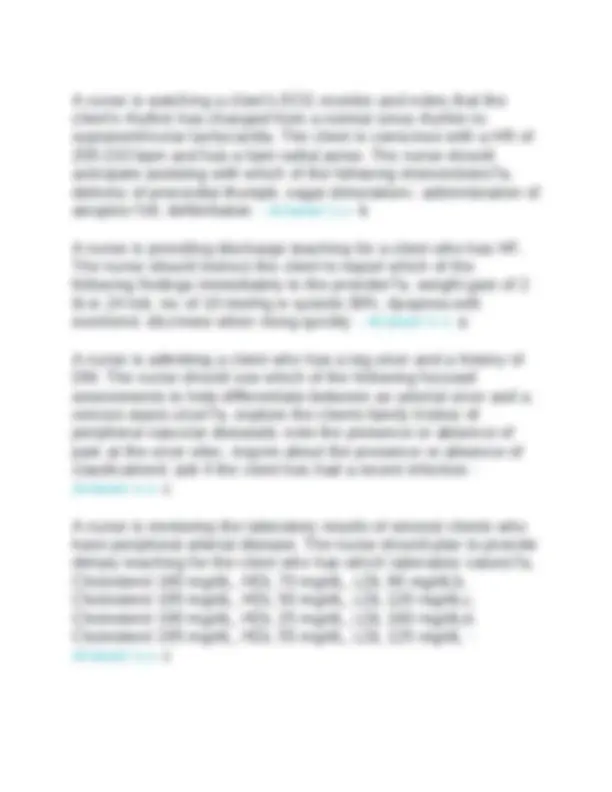
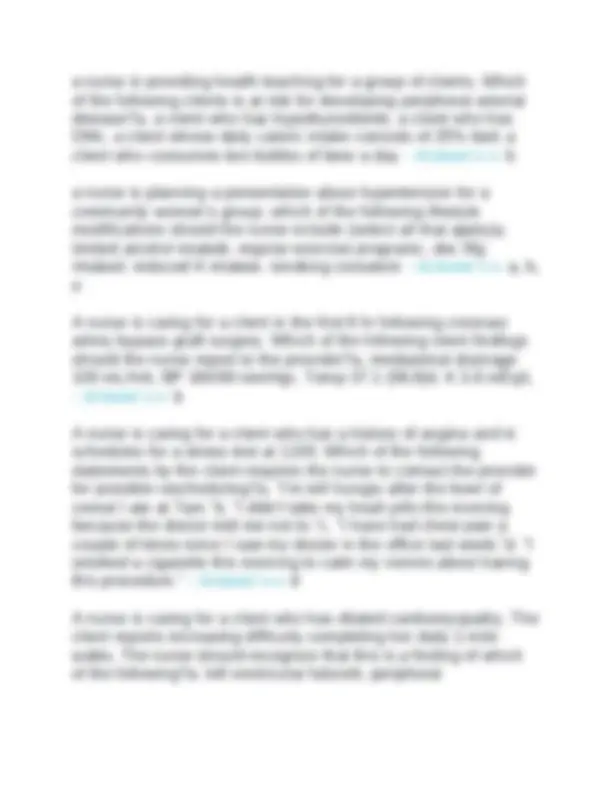
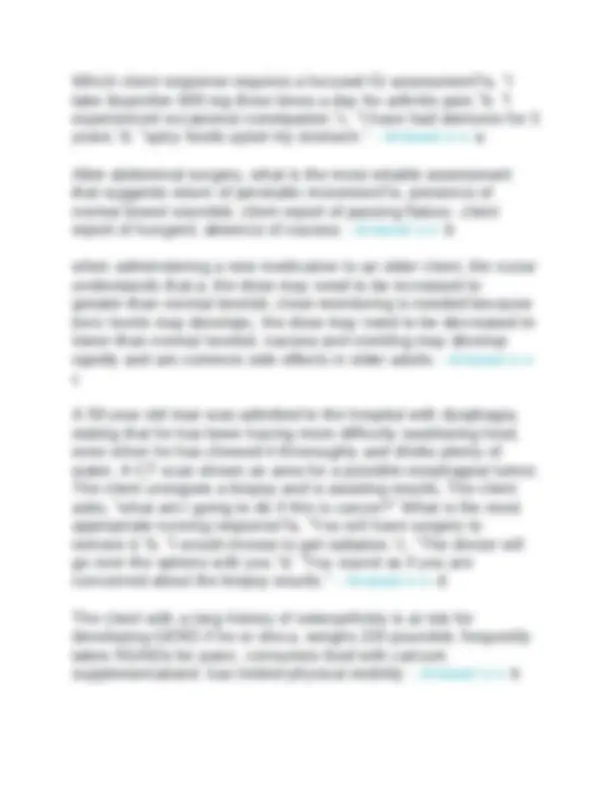
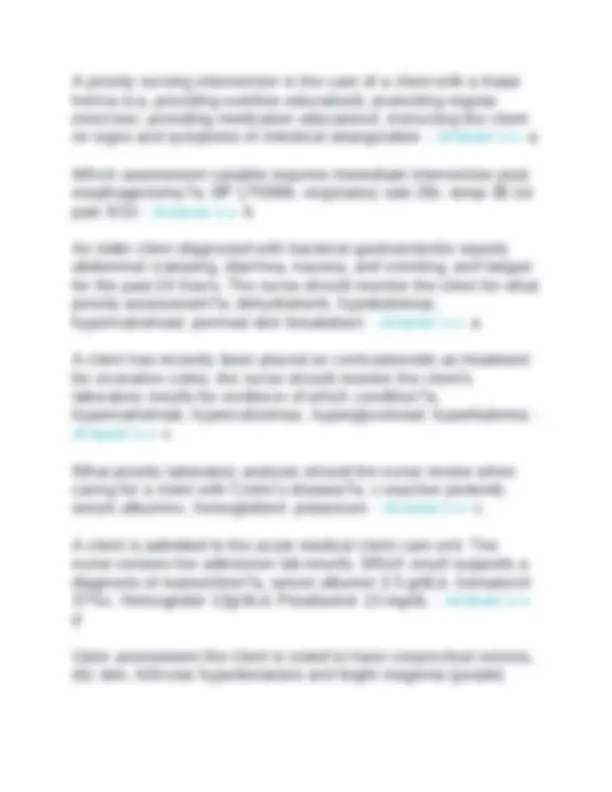
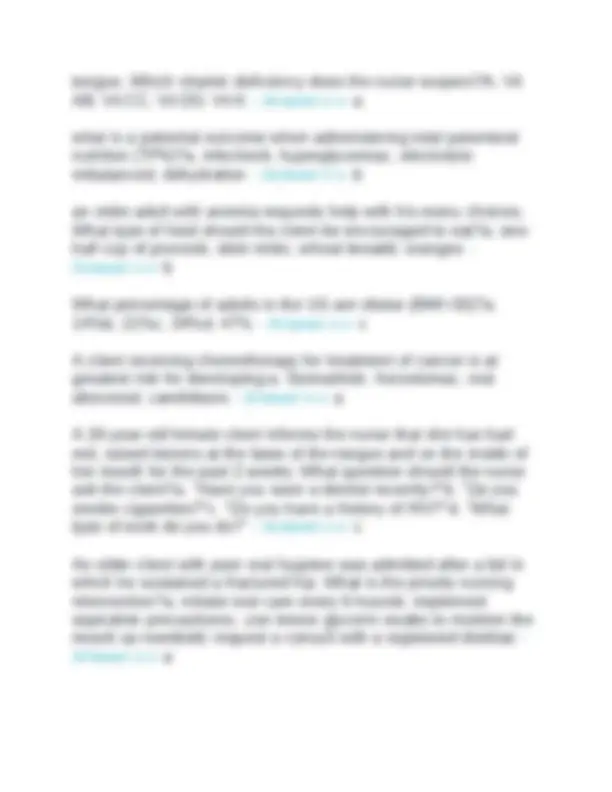
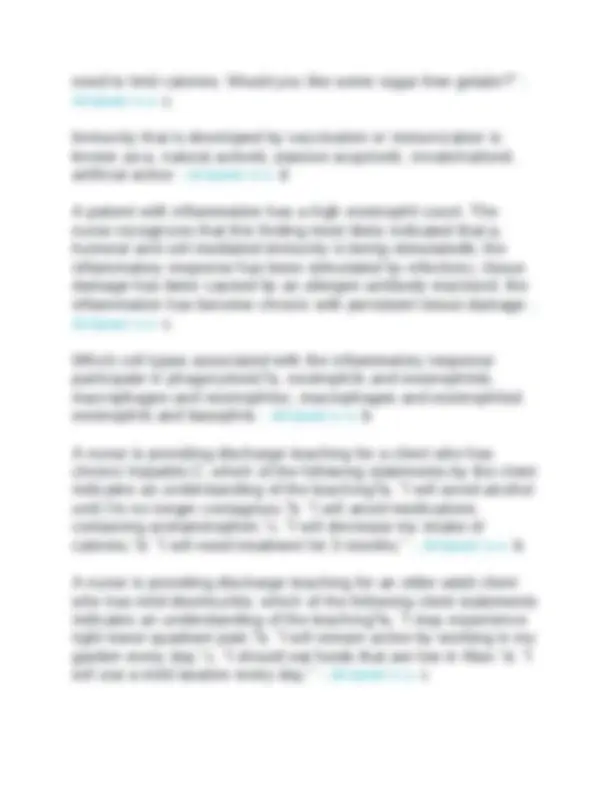
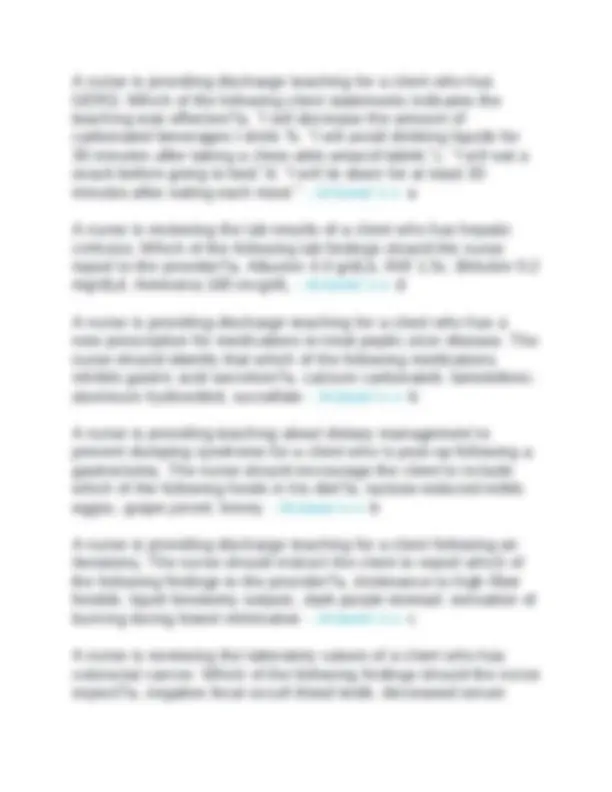
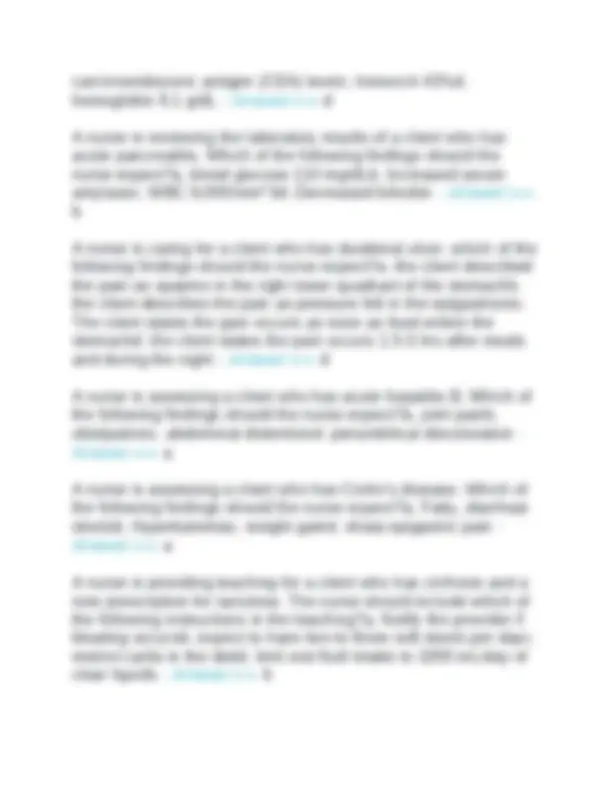
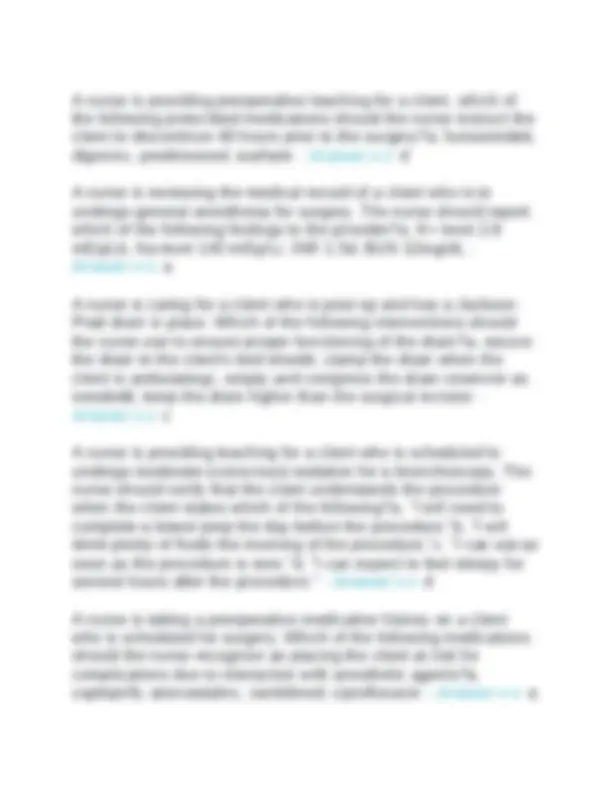
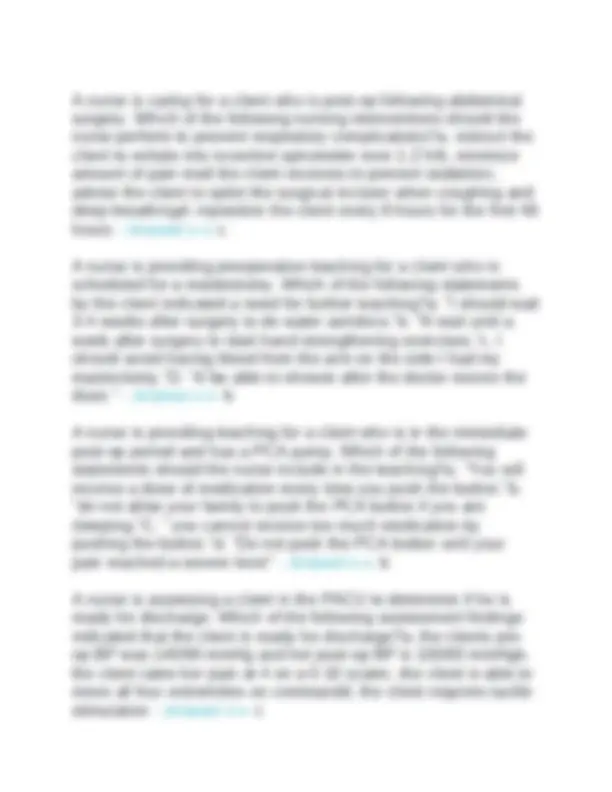

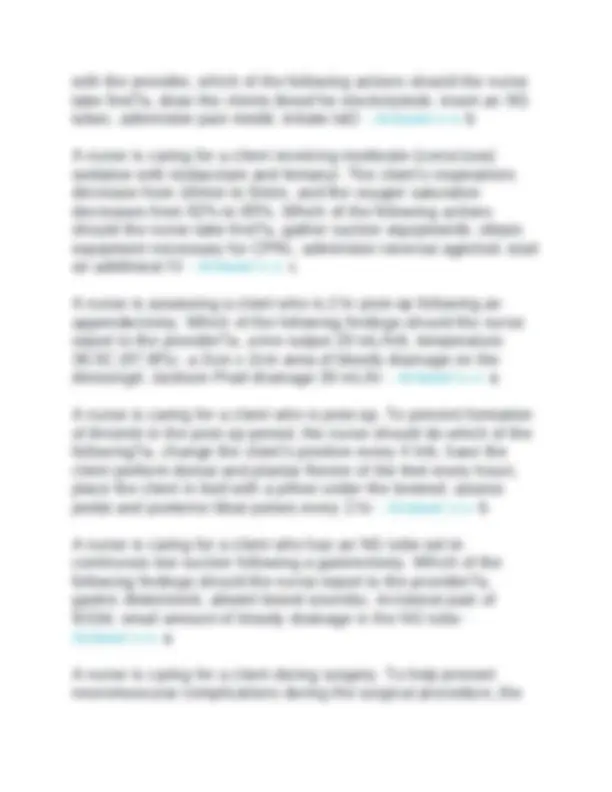
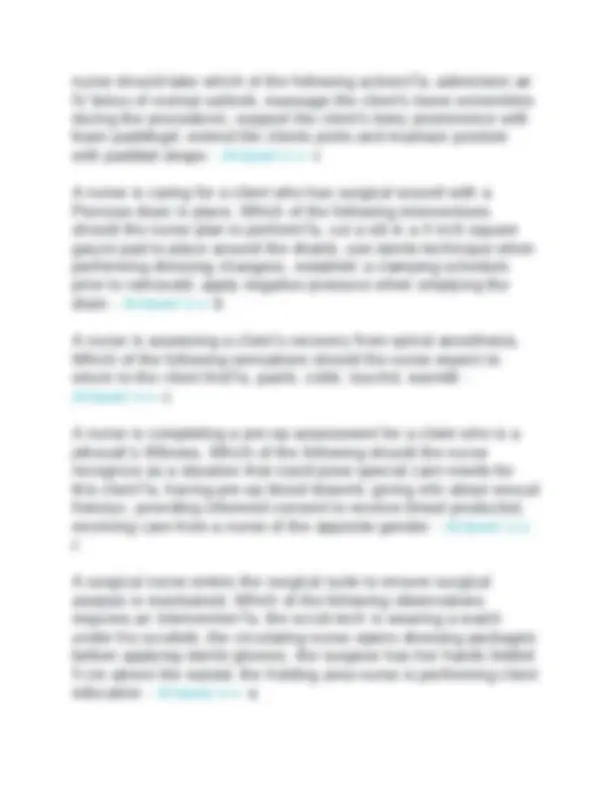
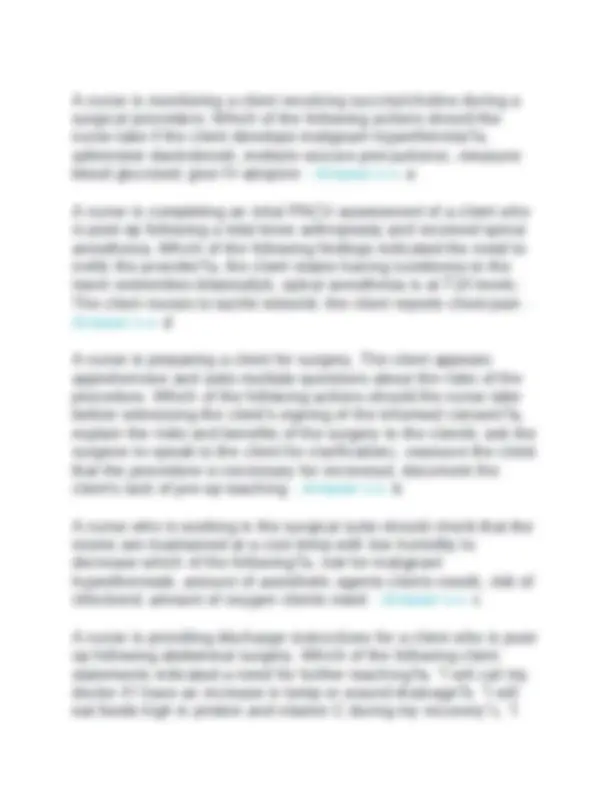
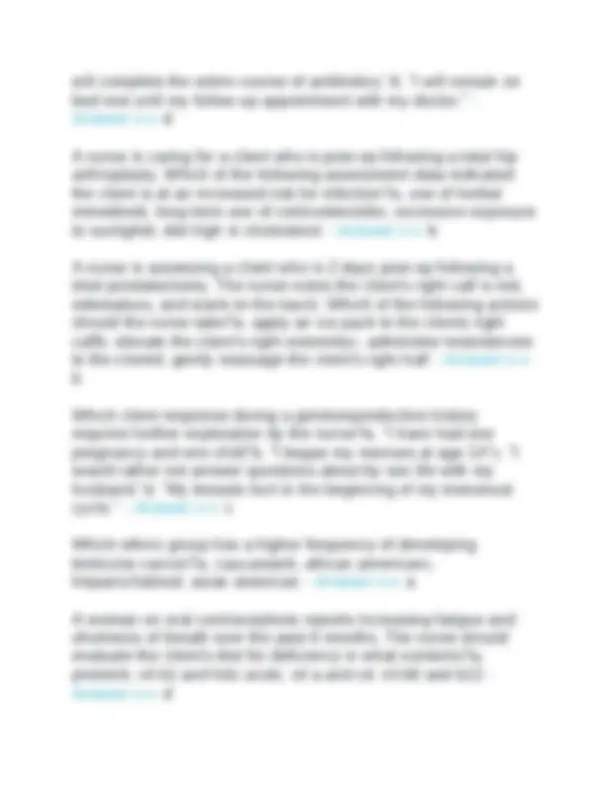
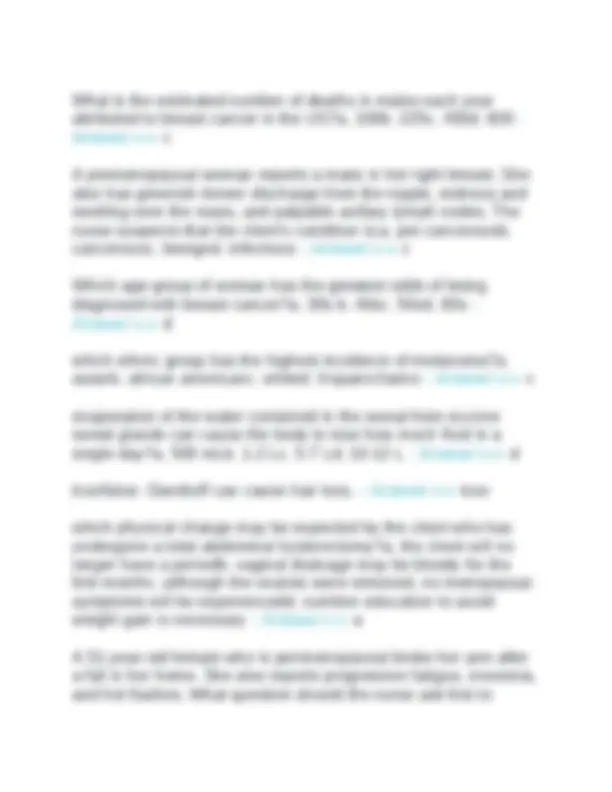
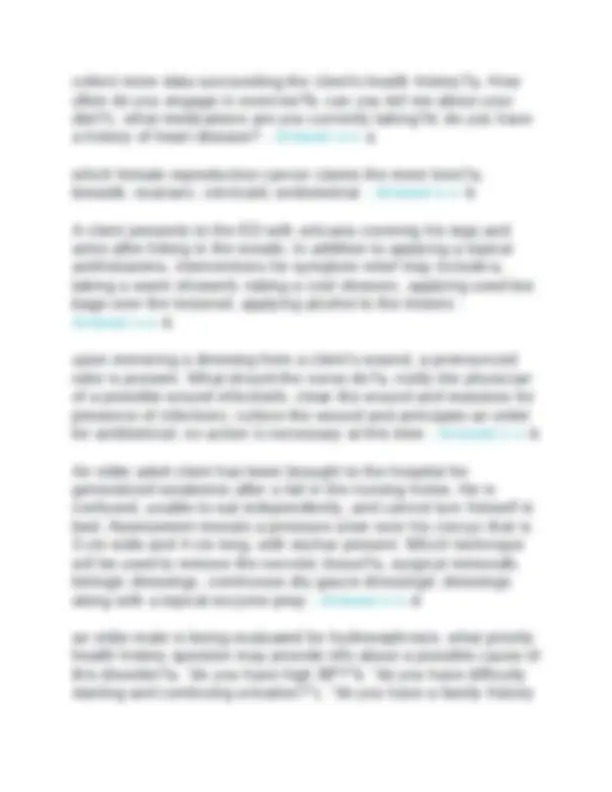
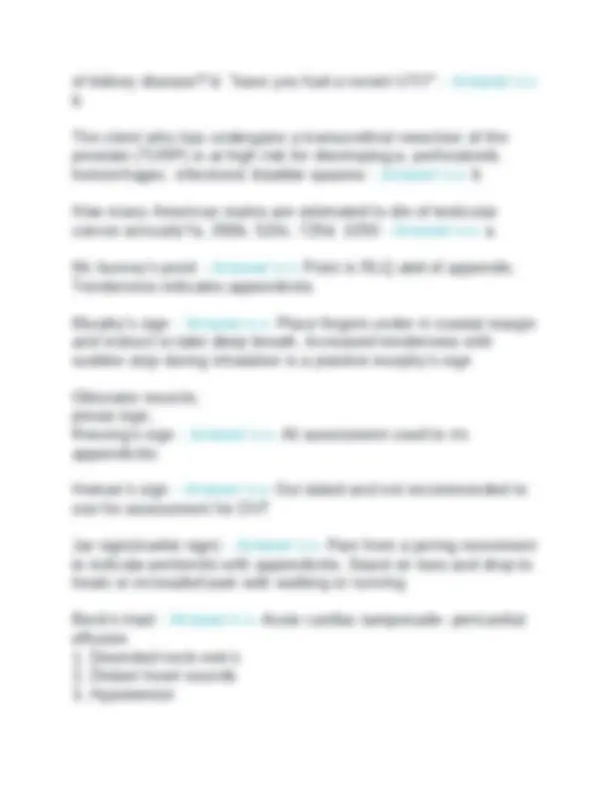
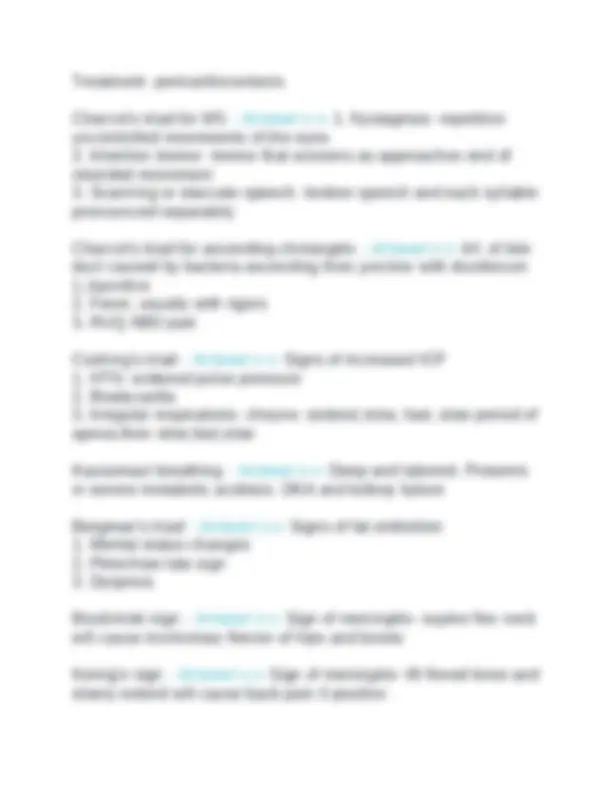
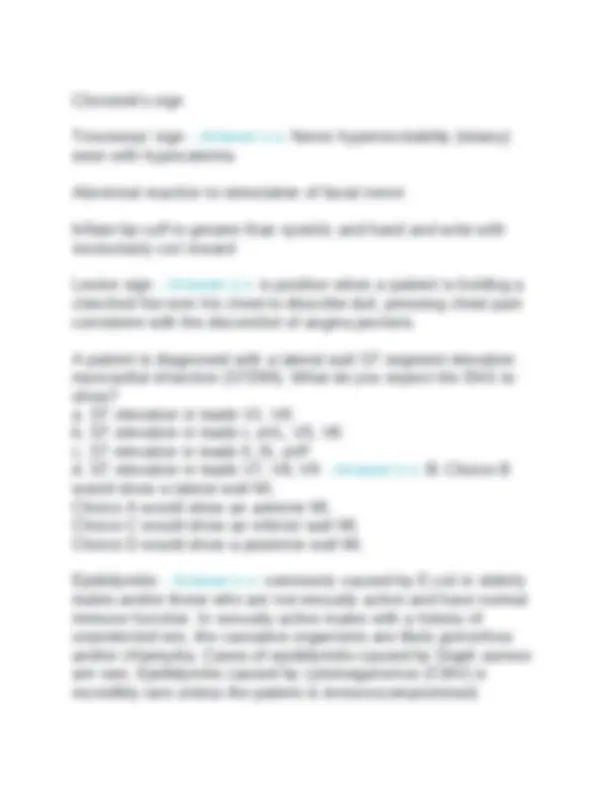
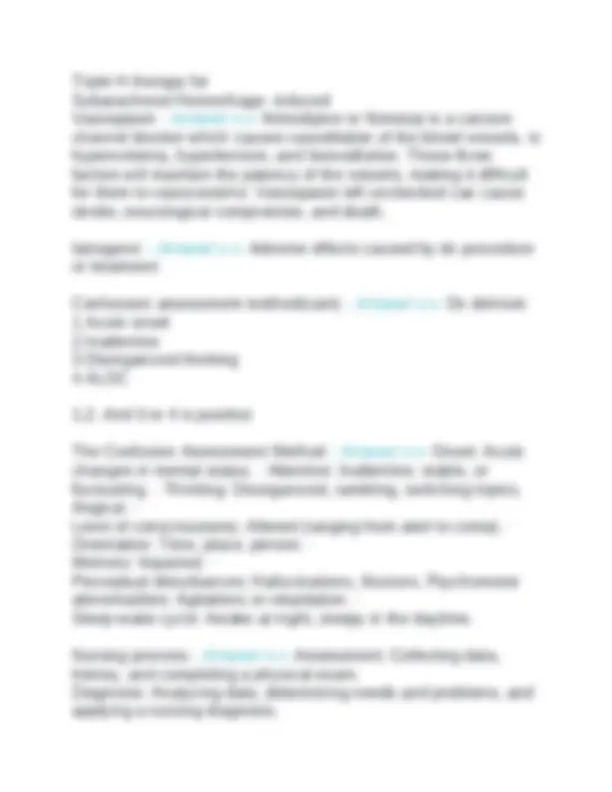
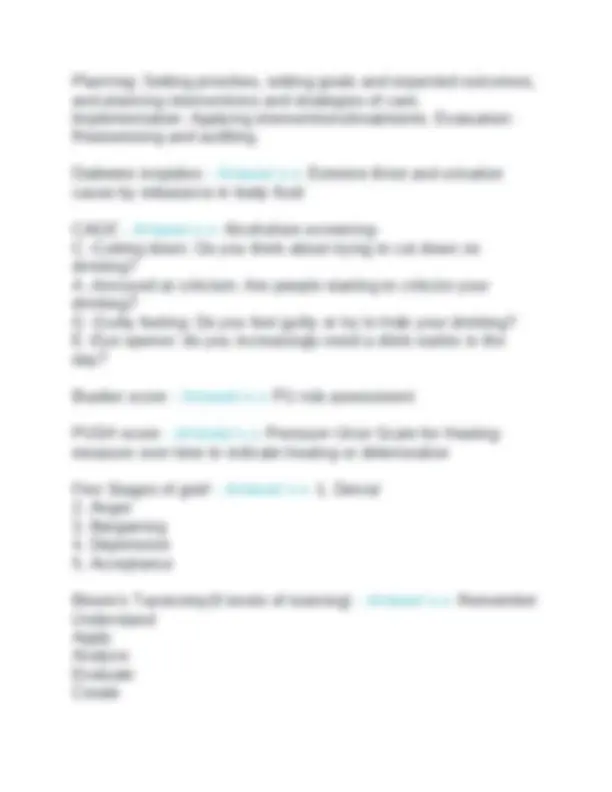
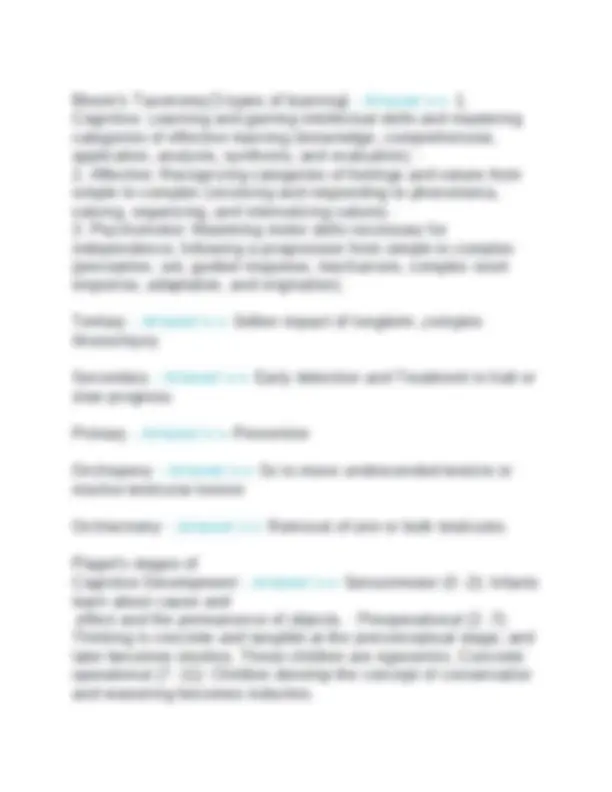
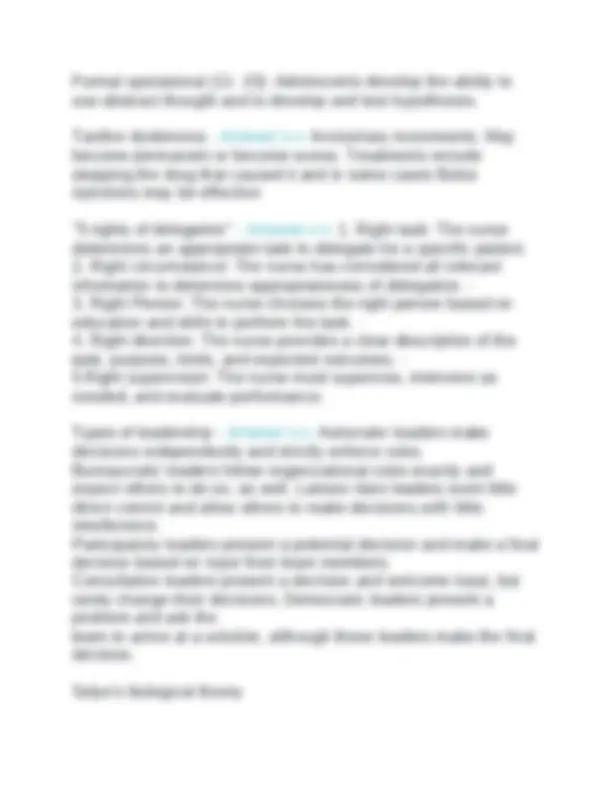
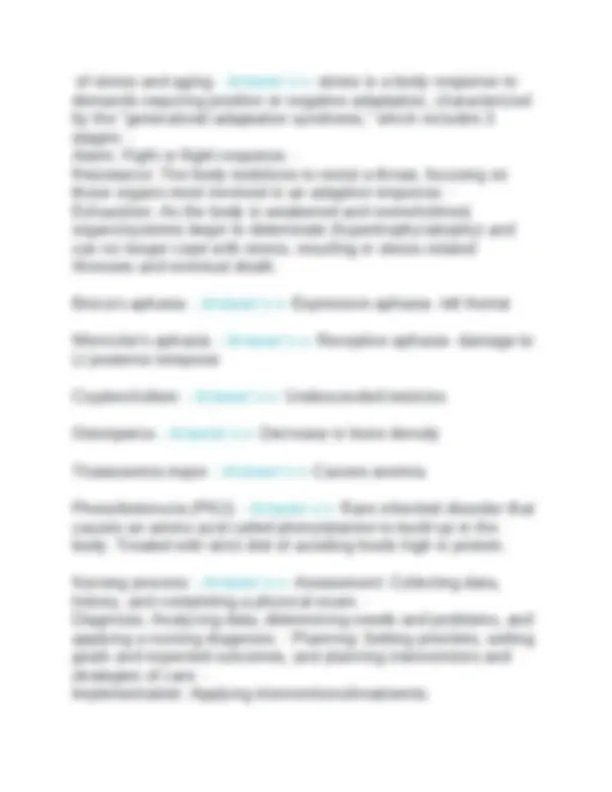
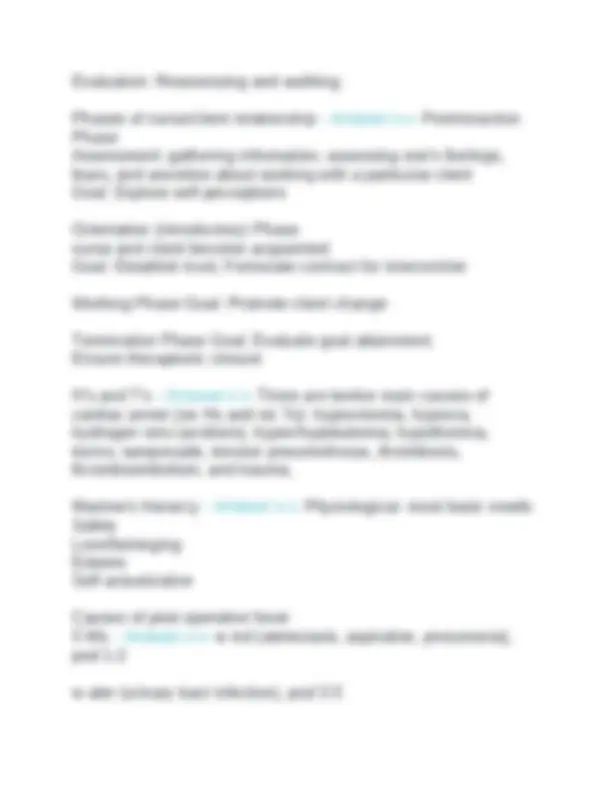
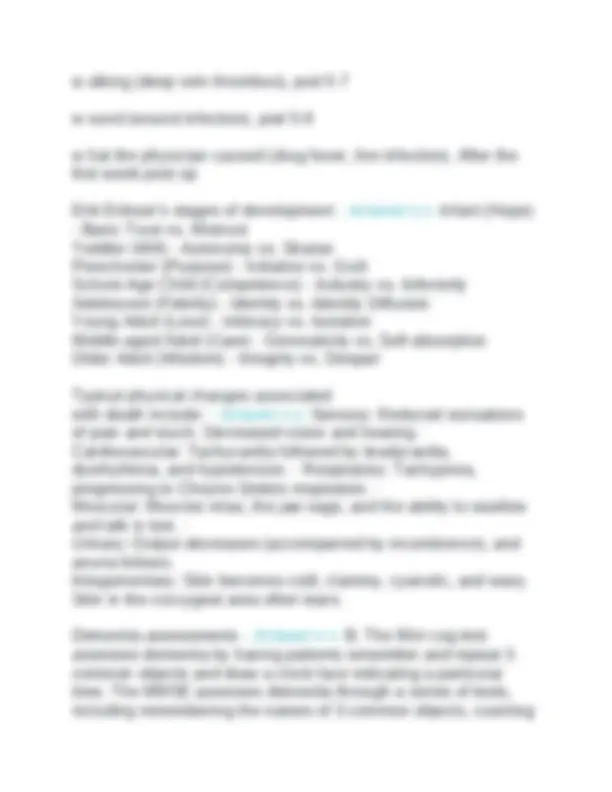
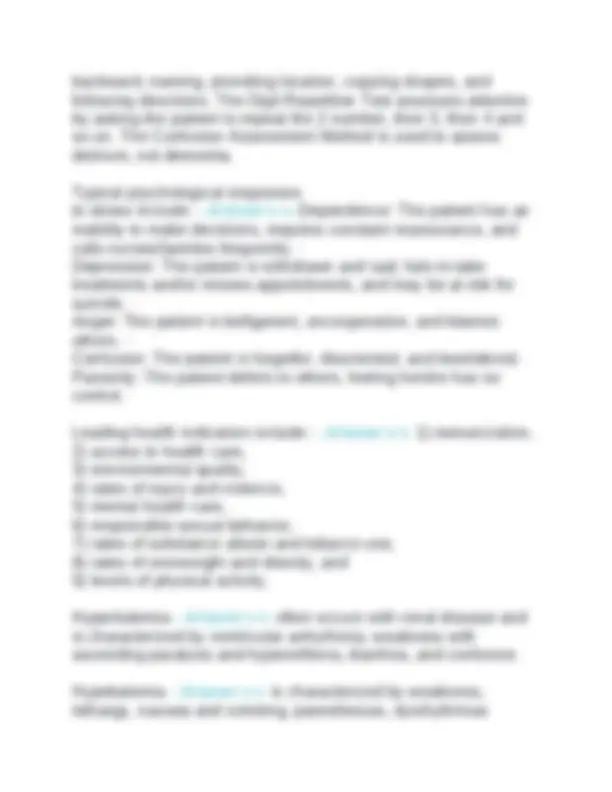
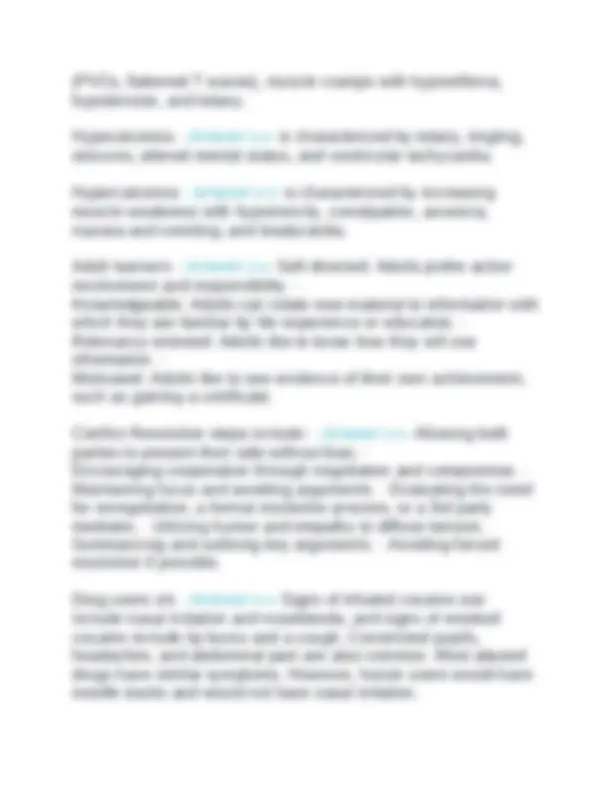

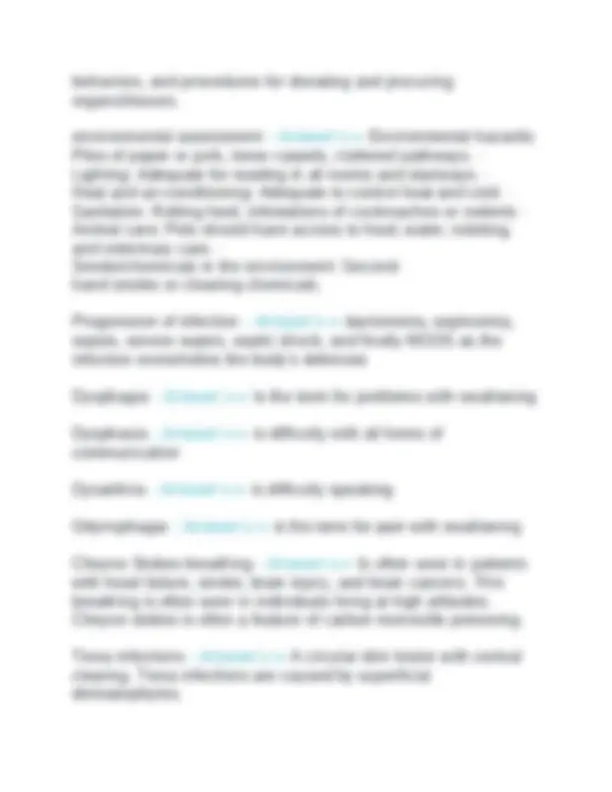
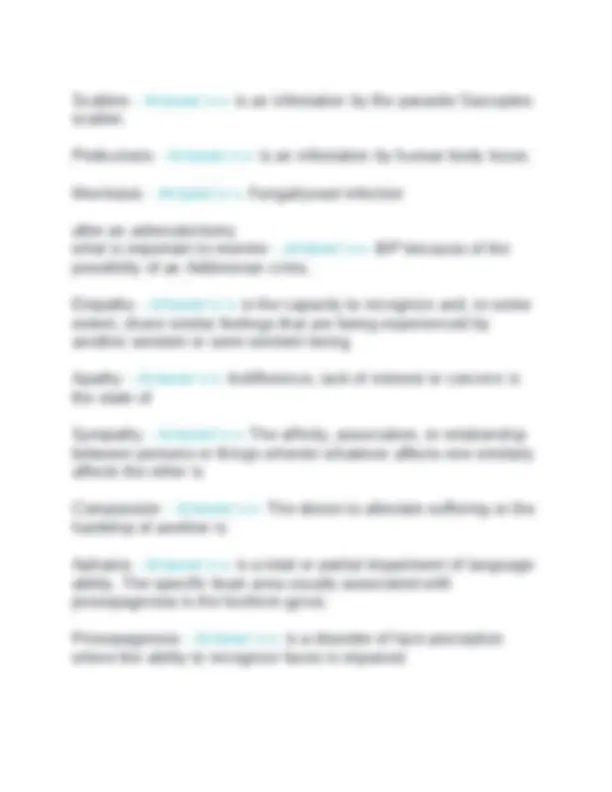
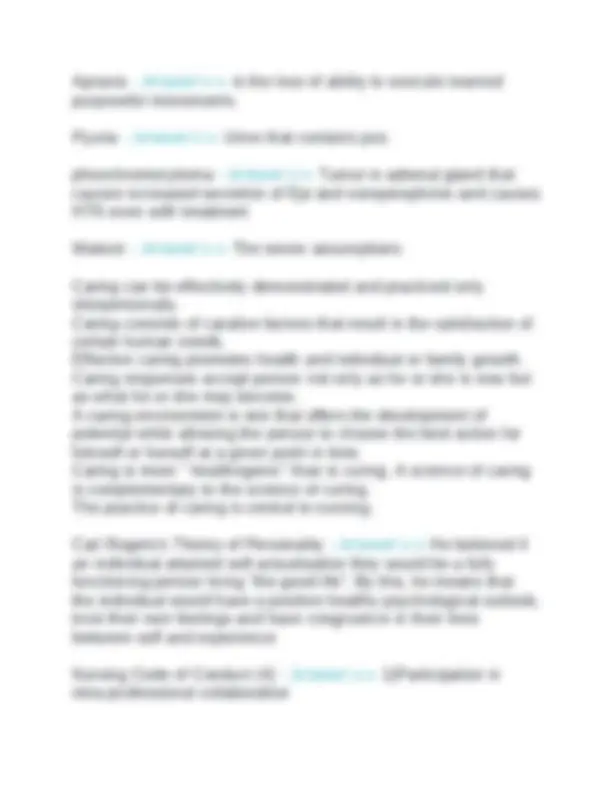
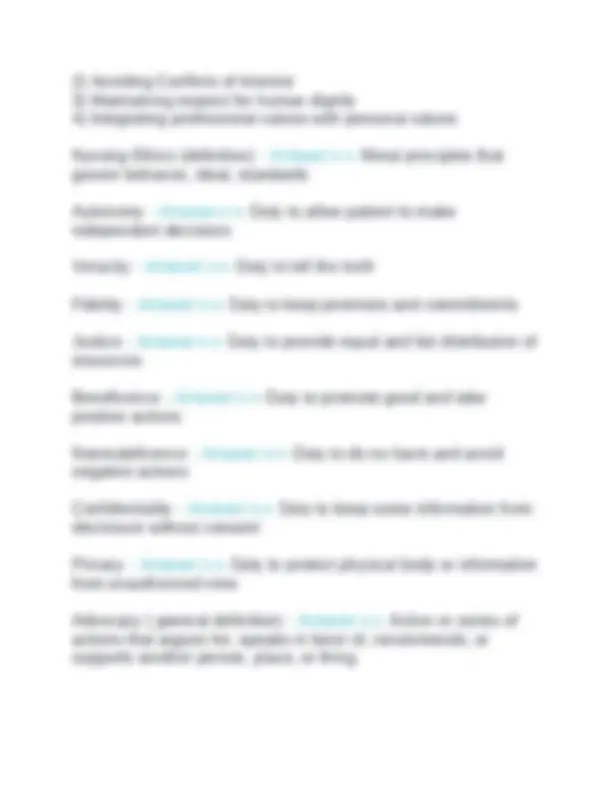
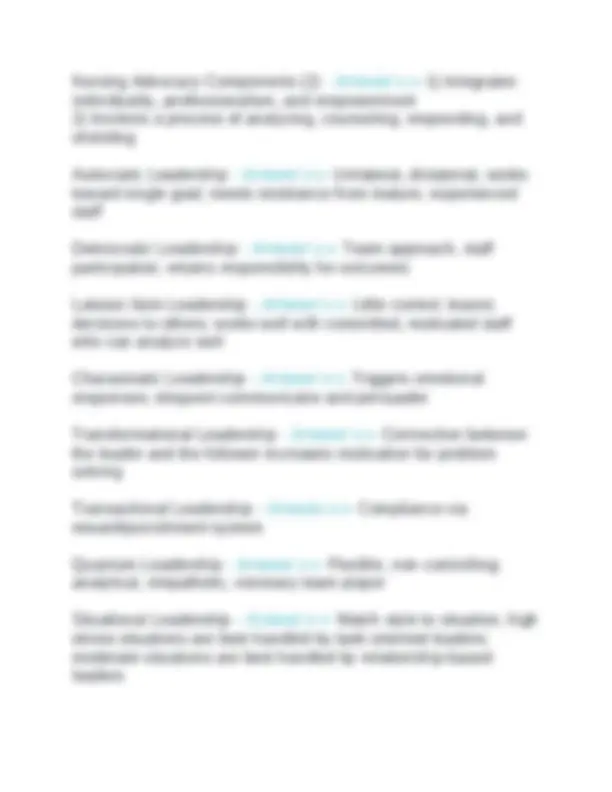
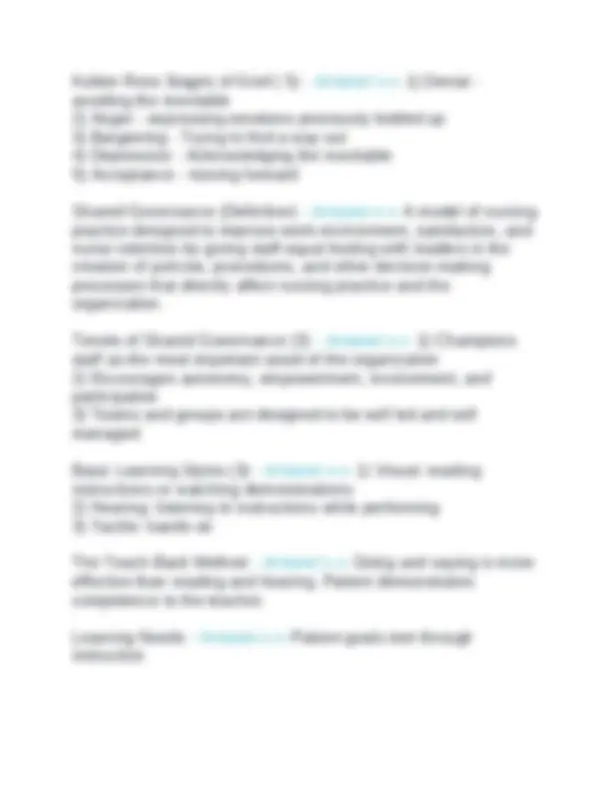
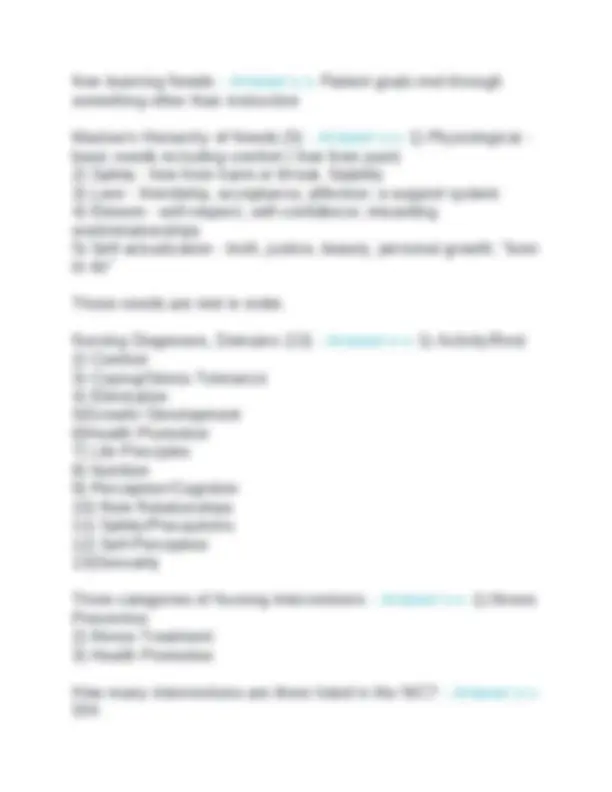
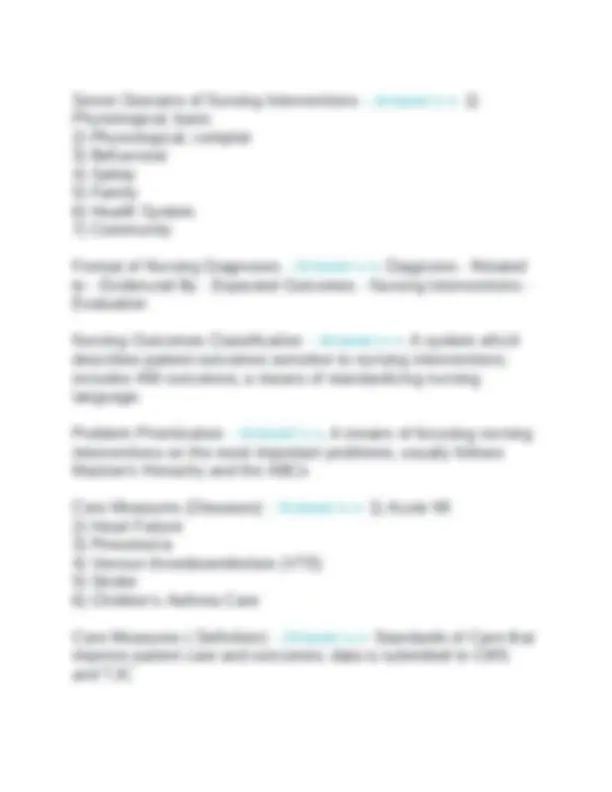
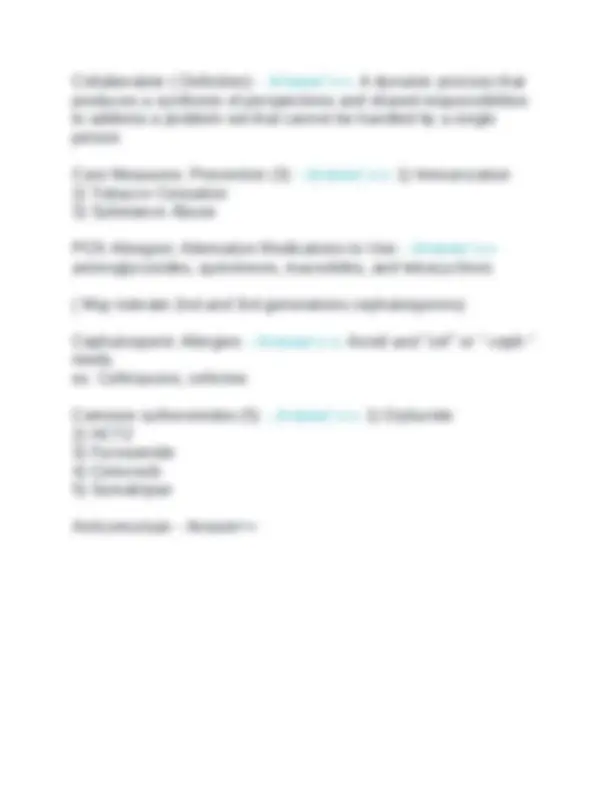


Study with the several resources on Docsity

Earn points by helping other students or get them with a premium plan


Prepare for your exams
Study with the several resources on Docsity

Earn points to download
Earn points by helping other students or get them with a premium plan
Community
Ask the community for help and clear up your study doubts
Discover the best universities in your country according to Docsity users
Free resources
Download our free guides on studying techniques, anxiety management strategies, and thesis advice from Docsity tutors
Various nursing care topics related to clients with gastrointestinal and hepatic disorders. It includes information on assessing and caring for clients with conditions such as heart failure, atrial fibrillation, peripheral arterial disease, coronary artery disease, and post-operative care. The document also discusses nursing interventions, patient education, and monitoring for clients with these types of disorders. The content provides a comprehensive overview of the nursing considerations and best practices for managing clients with gastrointestinal and hepatic conditions, making it a valuable resource for nursing students and professionals.
Typology: Exams
1 / 48

This page cannot be seen from the preview
Don't miss anything!









































A nurse is reviewing the medical record of a client who is receiving heparin therapy for treatment of DVT. Which of the following interventions should the nurse anticipate taking if the client's aPTT is 96 seconds?a. Increase the heparin infusion flow rate by 2 mL/hr b. continue to monitor the heparin infusion as prescribed c. request a prothrombin timed. stop the heparin infusion - Answer>> d A nurse is providing teaching for a client who is 2 days post-op following a heart transplant. Which of the following statements should the nurse include in the teaching?a. "you may no longer be able to feel chest pain."b. "your level of activity tolerance will not change."c. "after 6 months, you will no longer need to restrict your sodium intake."d. "you will be able to stop taking immunosuppressants after 12 months." - Answer>> a A nurse is assess a client in the emergency room who has a bradydysrhythmia. Which of the following findings should the nurse expect?A. confusionB. friction rubC. hypertensionD. dry skin - Answer>> a A nurse in the emergency department is caring for a client who had an anterior MI. The client's history reveals she is 1 week post-op open cholecystectomy. The nurse should recognize that which of the following interventions is contraindicated?A. administering IV morphine sulfateB. administering oxygen at 2 :/min via nasal cannulaC. helping the client to the bedside commodeD. assisting with thrombolytic therapy - Answer>> d
A nurse is caring for a client who has endocarditis. Which of the following findings should the nurse recognize as a potential complication?A. ventricular depolarizationB. Guillain-Barre syndromC. myelodysplastic syndromeD. Valvular disease - Answer>> D A nurse is caring for a client who presents to the ER with a BP of 254/138 mmHg. The nurse recognizes that the client is in a hypertensive crisis. Which of the following actions should the nurse take first?A. obtain blood samples for laboratory testingB. Tell the client to report vision changesC. Place the head of the bed at 45 degreesD. initiate an IV - Answer>> C a nurse is caring for a client who has HF and is experiencing AF. The nurse should plan to monitor for and report which of the following findings to the provider immediately?a. slurred speechb. irregular pulsec. dependent edemad. persistent fatigue - Answer>> a A nurse is assessing a client who has left-sided HF. Which of the following manifestations should the nurse expect to find?a. inc abdominal girthb. weak peripheral pulsesc. jugular vein distentiond. dependent edema - Answer>> b a nurse is caring for a client who is being treated for HF and has prescriptions for digoxin and furosemide. The nurse should plan to monitor for which of the following as an adverse effect of these medications?a. SOBb. lightheadednessc. dry coughd. metallic taste - Answer>> b a nurse is monitoring a client following coronary artery bypass graft surgery. Which of the following findings can indicate cardiac tamponade?a. sternal instabilityb. inc WBC countc. BP 140/ mmHg on inspiration and 154/90 mmHg on expirationd. sinus
A nurse is watching a client's ECG monitor and notes that the client's rhythm has changed from a normal sinus rhythm to supraventricular tachycardia. The client is conscious with a HR of 200-210 bpm and has a faint radial pulse. The nurse should anticipate assisting with which of the following interventions?a. delivery of precordial thumpb. vagal stimulationc. administration of atropine IVd. defibrillation - Answer>> b A nurse is providing discharge teaching for a client who has HF. The nurse should instruct the client to report which of the following findings immediately to the provider?a. weight gain of 2 lb in 24 hrb. inc of 10 mmHg in systolic BPc. dyspnea with exertiond. dizziness when rising quickly - Answer>> a A nurse is admitting a client who has a leg ulcer and a history of DM. The nurse should use which of the following focused assessments to help differentiate between an arterial ulcer and a venous stasis ulcer?a. explore the clients family history of peripheral vascular diseaseb. note the presence or absence of pain at the ulcer sitec. inquire about the presence or absence of claudicationd. ask if the client has had a recent infection - Answer>> c A nurse is reviewing the laboratory results of several clients who have peripheral arterial disease. The nurse should plan to provide dietary teaching for the client who has which laboratory values?a. Cholesterol 180 mg/dL, HDL 70 mg/dL, LDL 90 mg/dLb. Cholesterol 185 mg/dL, HDL 50 mg/dL, LDL 120 mg/dLc. Cholesterol 190 mg/dL, HDL 25 mg/dL, LDL 160 mg/dLd. Cholesterol 195 mg/dL, HDL 55 mg/dL, LDL 125 mg/dL - Answer>> c
a nurse is providing health teaching for a group of clients. Which of the following clients is at risk for developing peripheral arterial disease?a. a client who has hypothyroidismb. a client who has DMc. a client whose daily caloric intake consists of 25% fatd. a client who consumes two bottles of beer a day - Answer>> b a nurse is planning a presentation about hypertension for a community women's group. which of the following lifestyle modifications should the nurse include (select all that apply)a. limited alcohol intakeb. regular exercise programc. dec Mg intaked. reduced K intakee. smoking cessation - Answer>> a, b, e A nurse is caring for a client in the first 8 hr following coronary artery bypass graft surgery. Which of the following client findings should the nurse report to the provider?a. mediastinal drainage 100 mL/hrb. BP 160/80 mmHgc. Temp 37.1 (98.8)d. K 3.8 mEq/L
A client is being evaluated in the ED for a possible brain attack (stroke). Assessment findings consistent with a brain attack include which of the following? (select all that apply)a. facial droopb. slurred speechc. weakness of affected extremityd. crackles in lungse. decreased urine output - Answer>> a, b, c A client is admitted with a diagnosis of acute stroke. The provider orders "diet as tolerated." Before feeding this client, which nursing action is priority?a. determine client's food preferencesb. elevate the head of the bed 30 degreesc. assess client's swallowing reflexd. review serum albumin level to determine appropriate diet
Which client response requires a focused GI assessment?a. "I take ibuprofen 600 mg three times a day for arthritis pain."b. "I experienced occasional constipation."c. "I have had dentures for 3 years."d. "spicy foods upset my stomach." - Answer>> a After abdominal surgery, what is the most reliable assessment that suggests return of peristaltic movement?a. presence of normal bowel soundsb. client report of passing flatusc. client report of hungerd. absence of nausea - Answer>> b when administering a new medication to an older client, the nurse understands that:a. the dose may need to be increased to greater-than-normal levelsb. close monitoring is needed because toxic levels may developc. the dose may need to be decreased to lower-than-normal levelsd. nausea and vomiting may develop rapidly and are common side effects in older adults - Answer>> c A 59 year old man was admitted to the hospital with dysphagia, stating that he has been having more difficulty swallowing food, even when he has chewed it throroughly and drinks plenty of water. A CT scan shows an area for a possible esophageal tumor. The client unergoes a biopsy and is awaiting results. The client asks, "what am I going to do if this is cancer?" What is the most appropriate nursing response?a. "You will have surgery to remove it."b. "I would choose to get radiation."c. "The doctor will go over the options with you."d. "You sound as if you are concerned about the biopsy results." - Answer>> d The client with a long history of osteoarthritis is at risk for developing GERD if he or she:a. weighs 220 poundsb. frequently takes NSAIDs for painc. consumes food with calcium supplementationd. has limited physical mobility - Answer>> b
tongue. Which vitamin deficiency does the nurse suspect?A. Vit AB. Vit CC. Vit DD. Vit K - Answer>> a what is a potential outcome when administering total parenteral nutrition (TPN)?a. infectionb. hyperglycemiac. electrolyte imbalanced. dehydration - Answer>> b an older adult with anemia requests help with his menu choices. What type of food should the client be encouraged to eat?a. one- half cup of prunesb. skim milkc. wheat breadd. oranges - Answer>> b What percentage of adults in the US are obese (BMI>30)?a. 14%b. 21%c. 34%d. 47% - Answer>> c A client receiving chemotherapy for treatment of cancer is at greatest risk for developing:a. Stomatitisb. Xerostomac. oral abscessd. candidiasis - Answer>> a A 26-year-old female client informs the nurse that she has had red, raised lesions at the base of the tongue and on the inside of her mouth for the past 2 weeks. What question should the nurse ask the client?a. "Have you seen a dentist recently?"b. "Do you smoke cigarettes?"c. "Do you have a history of HIV?"d. "What type of work do you do?" - Answer>> c An older client with poor oral hygiene was admitted after a fall in which he sustained a fractured hip. What is the priority nursing intervention?a. initiate oral care every 6 hoursb. implement aspiration precautionsc. use lemon glycerin swabs to moisten the mouth as neededd. request a consult with a registered dietitian - Answer>> a
A nurse is reviewing the prescriptions for a client who has Campylobacter enteritis. Which of the following prescriptions should the nurse clarify with the provider?a. 0.45% sodium chloride IVb. Milk of Magnesiac. Ciprofloxacind. Potassium - Answer>> b A nurse is caring for a client who has GERD and a new prescription for metoclopramide. The nurse should plan to monitor for which of the following adverse effects?a. Thrombocytopeniab. hearing lossc. hypotensiond. ataxia - Answer>> d A nurse is caring for a client who has colorectal cancer and is recieving chemotherapy. The client asks the nurse why blood is being drawn for a carcinoembryonic antigen (CEA) level. Which of the following responses by the nurse is appropriate?a. "The CEA determines the current stage of you colon cancer."b. "The CEA determines the efficacy of your chemotherapy."c. "The CEA determines if the neutrophil count is below the expected reference range."d. "The CEA determines if you are experiencing occult bleeding from the GI tract." - Answer>> b A nurse is providing discharge teaching for a client who has chronic cholecystitis. Which of the following food selections by the client indicated the teaching was effective?a. unsalted nutsb. bolognac. cheddar cheesed. bananas - Answer>> d A nurse is providing discharge for a client who has gastritis and a new prescription for famotidine. Which of the following client statements indicated the teaching was effective?a. "I should make sure the water I drink is filtered."b. "I should expect immediate pain relief after starting this therapy."c. "I will drink iced tea with my meals and snacks."d. "I will monitor by blood glucose level regularly while taking this medication." - Answer>> a
need to limit calories. Would you like some sugar-free gelatin?" - Answer>> c Immunity that is developed by vaccination or immunization is known as:a. natural activeb. passive acquiredc. innate/natived. artificial active - Answer>> d A patient with inflammation has a high eosinophil count. The nurse recognizes that this finding most likely indicated that:a. humoral and cell-mediated immunity is being stimulatedb. the inflammatory response has been stimulated by infectionc. tissue damage has been caused by an allergen-antibody reactiond. the inflammation has become chronic with persistent tissue damage - Answer>> c Which cell types associated with the inflammatory response participate in phagocytosis?a. neutrophils and eosinophilsb. macrophages and neutrophilsc. macrophages and eosinophilsd. eosinophils and basophils - Answer>> b A nurse is providing discharge teaching for a client who has chronic hepatitis C. which of the following statements by the client indicates an understanding of the teaching?a. "I will avoid alcohol until I'm no longer contagious."b. "I will avoid medications containing acetaminophen."c. "I will decrease my intake of calories."d. "I will need treatment for 3 months." - Answer>> b A nurse is providing discharge teaching for an older adult client who has mild diverticulitis. which of the following client statements indicates an understanding of the teaching?a. "I may experience right lower quadrant pain."b. "I will remain active by working in my garden every day."c. "I should eat foods that are low in fiber."d. "I will use a mild laxative every day." - Answer>> c
A nurse is providing discharge teaching for a client who has GERD. Which of the following client statements indicates the teaching was effective?a. "I will decrease the amount of carbonated beverages I drink."b. "I will avoid drinking liquids for 30 minutes after taking a chew-able antacid tablet."c. "I will eat a snack before going to bed."d. "I will lie down for at least 30 minutes after eating each meal." - Answer>> a A nurse is reviewing the lab results of a client who has hepatic cirrhosis. Which of the following lab findings should the nurse report to the provider?a. Albumin 4.0 g/dLb. INR 1.5c. Bilirubin 0. mg/dLd. Ammonia 180 mcg/dL - Answer>> d A nurse is providing discharge teaching for a client who has a new prescription for medications to treat peptic ulcer disease. The nurse should identify that which of the following medications inhibits gastric acid secretion?a. calcium carbonateb. famotidinec. aluminum hydroxided. sucralfate - Answer>> b A nurse is providing teaching about dietary management to prevent dumping syndrome for a client who is post-op following a gastrectomy. The nurse should encourage the client to include which of the following foods in his diet?a. lactose-reduced milkb. eggsc. grape juiced. honey - Answer>> b A nurse is providing discharge teaching for a client following an ileostomy. The nurse should instruct the client to report which of the following findings to the provider?a. intolerance to high-fiber foodsb. liquid ileostomy outputc. dark purple stomad. sensation of burning during bowel elimination - Answer>> c A nurse is reviewing the laboratory values of a client who has colorectal cancer. Which of the following findings should the nurse expect?a. negative fecal occult blood testb. decreased serum
A nurse is admitting a client who has acute pancreatitis. Which of the following actions should the nurse take first?a. insert an NG tubeb. administer ceftazidimec. identify the clients current level of paind. instruct the client to remain NPO - Answer>> c A nurse is teaching a client how to prepare for a colonoscopy. which of the following instructions should the nurse include in the teaching?a. begin drinking the oral liquid preparation for bowel cleansing on the morning of the procedureb. drink full liquids for breakfast the day of the procedure, and then take nothing by mouth for 2 hr prior to the procedurec. drink clear liquids for 24 hr prior to the procedure, and then take NPO by mouth for 6 hr before the procedured. Drink oral liquid preparation for bowel cleansing slowly - Answer>> c A nurse is developing a plan of care for a client who has cirrhosis and ascites. Which of the following interventions should the nurse include?a. measure abdominal girth dailyb. administer warfarin at the same time each dayc. provide a daily intake of 4 g of sodiumd. assess breath sounds every 12 hours - Answer>> a A nurse is assessing a client who has upper GI bleeding. Which of the following findings should the nurse expect?a. hypoactive bowel soundsb. epigastric painc. hypotensiond. pernicious anemia - Answer>> c A nurse is caring for a client who has ulcerative colitis. The client has had several exacerbation over the past 3 years. Which of the following instructions should the nurse include in the plan of care to minimize the risk of further exacerbation (select all that apply)a. use progressive relaxation techniquesb. increase dietary fiber intakec. drink two 240 mL (8oz) glasses of milk per dayd. arrange activities to allow for daily rest periodse. restrict intake of carbonated beverages - Answer>> a, d, e
A nurse is assessing a client immediately following a paracentesis for the treatment of ascities. Which of the following findings indicates the procedure was effective?a. presence of a fluid waveb. increased HRc. equal pre- and post-procedure weightsd. decreased shortness of breath - Answer>> d A nurse is providing discharge teaching for a client who has a new colostomy and is concerned about flatus and odor. Which of the following foods should the nurse recommend?a. eggsb. fishc. yogurtd. broccoli - Answer>> c A nurse is assessing a client who has cirrhosis. Which of the following findings is the priority for the nurse to report to the provider?a. spider angiomasb. peripheral edemac. bloody stoolsd. jaundice - Answer>> c Which clinical manifestation reported by a client suggests to the nurse that anemia is a possibility?a. difficulty sleepingb. cold hands and feetc. chronic headachesd. shortness of breath - Answer>> d A nurse is caring for a client who has a new prescription for clindamycin to treat acute pelvic inflammatory disease. The nurse should monitor for and report which of the following findings immediately to the provider?a. watery diarrheab. vaginitisc. feverd. nausea and vomiting - Answer>> a A nurse is providing preoperative teaching to a client who is scheduled for a gastrectomy in 1 week. The client is anxious about the upcoming surgery. Which of the following is an appropriate action for the nurse to take?a. sympathize with the clients feelingsb. reassure the client that the surgery will go finec. change the topic of discussiond. provide concise, factual information - Answer>> d
A nurse is caring for a client who is post-op following abdominal surgery. Which of the following nursing interventions should the nurse perform to prevent respiratory complications?a. instruct the client to exhale into incentive spirometer ever 1-2 hrb. minimize amount of pain med the client receives to prevent sedationc. advise the client to splint the surgical incision when coughing and deep breathingd. reposition the client every 8 hours for the first 48 hours - Answer>> c A nurse is providing preoperative teaching for a client who is scheduled for a mastestomy. Which of the following statements by the client indicated a need for further teaching?a. "I should wait 3-4 weeks after surgery to do water aerobics."b. "Ill wait until a week after surgery to start hand strengthening exercises."c. I should avoid having blood from the arm on the side I had my mastectomy."D. "ill be able to shower after the doctor moves the drain." - Answer>> b A nurse is providing teaching for a client who is in the immediate post-op period and has a PCA pump. Which of the following statements should the nurse include in the teaching?a. "You will receive a dose of medication every time you push the button."b. "do not allow your family to push the PCA button if you are sleeping."C. " you cannot receive too much medication by pushing the button."d. "Do not push the PCA button until your pain reached a severe level" - Answer>> b A nurse is assessing a client in the PACU to determine if he is ready for discharge. Which of the following assessment findings indicated that the client is ready for discharge?a. the clients pre- op BP was 140/90 mmHg and her post-op BP is 100/65 mmHgb. the client rates her pain at 4 on a 0-10 scalec. the client is able to move all four extremities on commandd. the client requires tactile stimulation - Answer>> c
A nurse is receiving afternoon report on four clients who have returned from the PACU this morning. The nurse should assess which of the following clients first?a. a client who is post-op following a thoractomy has a chest tube with 150 mL bright-red of blood in the collection chamber from the past hourb. a client who is post-op following a small bowel resection and has a temporary colostomy has absent bowel sounds in all four quadrantsc. a client who is post-op following a tonsillectomy has had one episode of coffee-ground emesisd. a client who is post-op following a total knee arthroplasty and has a PCA pump is reporting a knee pain level of 7/10 - Answer>> a A client is transferred from the surgical suite to the PACU following oral surgery. While monitoring the client's vital signs, the nurse finds that the tongue has become swollen and is obstructing the airway. Which of the following actions should the nurse take first?a. contact the anesthesiologistb. assist with endotracheal intubationc. increase the clients flow of oxygend. use the head-tilt, chin-lift method to open the airway - Answer>> d A client had an open transverse colectomy 5 days ago. The nurse enters the client's room and recognizes that the wound has eviscerated. After covering the wound with a sterile, saline- soaked dressing, which of the following actions should the nurse take?a. go to the nurses station to seek assistanceb. reinsert the organs into the abdominal cavityc. place the client in reverse Trendelenburg positiond. obtain vital signs to assess for shock - Answer>> d A nurse is caring for a client who is 2 days post-op following a cholecystectomy. The client has been vomiting for the past 24 hours and reports a pain level of 8/10. The nurse notes a hard, distended abdomen and absent bowel sounds. After conferring